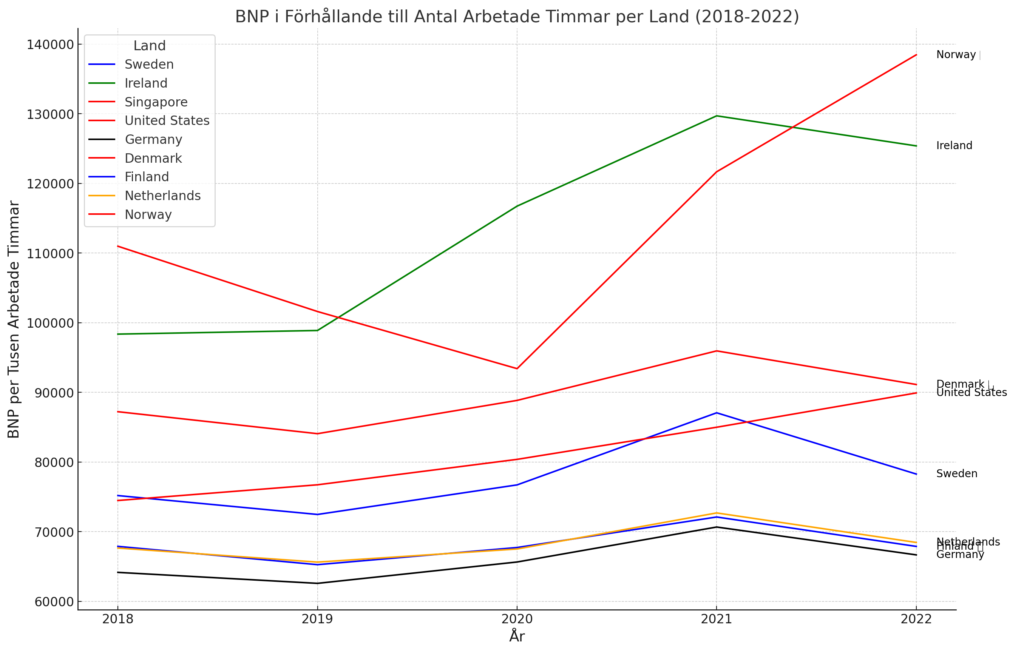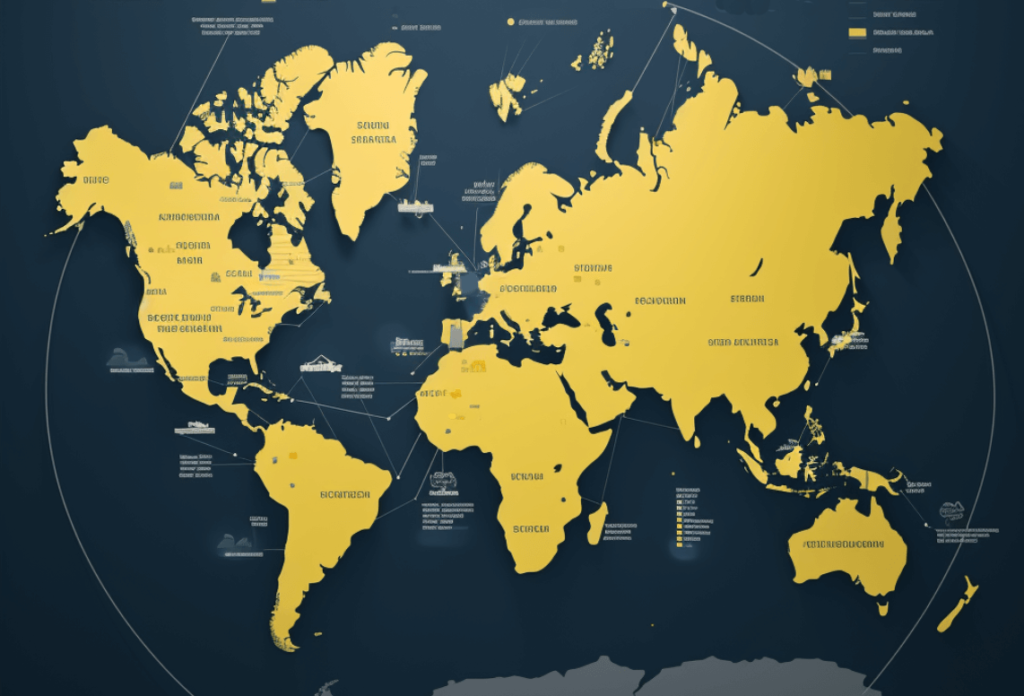Here is a comparison table showing Sweden and the selected countries with higher GDP per capita, including both EU and non-EU countries. Regarding the macro economy, the numbers do not look good with weak GDP growth and review. The American investor Ray Dalio talks about the renaissance countries where he has Middle Eastern countries such as Qatar and the United Arab Emirates (Emirates).
| Country | GDP per capita USD 2023 IMF | Budget balance forecast | Current Account Forecast | Economic Growth Forecast | Inflation forecast | Investment forecast | Unemployment forecast |
|---|---|---|---|---|---|---|---|
| Luxembourg | 143304 | -0.52 | 4.30 | 1.10 | 2.55 | 17.70 | 5.08 |
| Qatar | 114210 | ||||||
| Ireland | 137638 | 2.25 | 8.19 | 5.58 | 3.01 | 27.42 | 4.48 |
| Singapore | 133108 | 0.68 | 15.50 | 1.50 | 5.45 | 25.12 | 2.10 |
| Norway | 82236 | -6.81 | 25.39 | 2.15 | 2.90 | 21.94 | 3.50 |
| USA | 80412 | -6.59 | -2.71 | 1.58 | 3.05 | 20.95 | 3.83 |
| Netherlands | 73317 | -2.34 | 6.30 | 1.03 | 2.37 | 21.23 | 3.90 |
| Denmark | 74958 | 0.55 | 9.45 | NaN | 3.80 | 25.29 | 5.10 |
| Emirates | 68453 | ||||||
| Germany | 66038 | -3.22 | 4.67 | -0.11 | 3.62 | 23.75 | 3.27 |
| Sweden | 66209 | 0.43 | 3.87 | -0.48 | 5.80 | 27.21 | 7.80 |
| Finland | 59869 | -2.23 | -3.37 | 0.05 | 5.30 | 26.44 | 7.47 |
- Budget balance forecast: This is a forecast of the difference between a nation's income (mainly via taxes) and expenditure. A positive number means a surplus, and a negative number means a deficit. For Sweden, the figure is 0.43, which indicates a small surplus in the budget. Sweden has a relatively stable budget balance compared to other countries, but Ireland, Singapore and Denmark also have positive balances.
- Current account forecast: This is a measure of a country's trade balance plus net income and direct payments across borders. A positive value means that the country exports more than it imports. Sweden has 3.87, indicating a healthy trade balance. Norway and Singapore have the highest account forecast, but EU countries such as Denmark, the Netherlands and Germany are also doing well.
- Economic growth forecast: This figure shows the expected growth in a country's gross domestic product (GDP). A positive number indicates economic growth. Sweden's -0.48 indicates a minor economic downturn. Countries such as Ireland and Singapore show strong economic growth figures.
- Inflation forecast: This is an expectation of the change in the price level in a country over time. Higher numbers mean higher expected inflation. Sweden's figure is 5.80, which points to an expected high inflation.
- Investment forecast: This shows the expected level of investment in the economy. Higher numbers indicate higher investment levels. Sweden's figure is 27.21, which is relatively high and may indicate good future economic opportunities.
- Unemployment forecast: This is an expectation of the unemployment rate. Higher numbers indicate higher expected unemployment. Sweden's figure is 7.80, which is higher compared to many of the other compared countries and may point to challenges in the labor market. Sweden has higher unemployment figures than the comparable countries.
Sweden's weaknesses
In an interesting video on YouTube, it is discussed how the perspective of immigrants can shed light on certain shortcomings in Sweden. The video discusses issues related to the banking systems, especially the challenges of foreigners not getting bank cards and difficulties connected to payments in online shops. It also addresses PostNord's lack of service and the general experience of slow and ineffective customer service in the country. In addition, there is a reflection on the Swedish fika culture, which is considered to have 'derailed'. These points give a unique insight into how Sweden is experienced from an immigrant perspective.
Sweden's strengths in the long term
Sweden excels in many areas compared to other countries, which is reflected in its many strengths:
- Innovation: The country is known for its high level of innovation, often ranked among the top in the world.
- Workforce demographics: Demographically, Sweden has a favorable composition of people of working age (15-64 years), which is in sharp contrast to countries such as Germany and China where this demographic is on the decline.
- University education: Swedish universities are known for their high quality and regularly rank well in international comparisons.
- Green technology and sustainability: Sweden is a forerunner in the field of green technology and sustainability issues, with significant progress and innovations in this area.
- Care and health: The country is a world leader in care and health, known for its high-quality and accessible healthcare.
- Energy resources: Sweden has a strong position in terms of energy availability, with a significant portion of energy production coming from renewable sources.
What should be done?
In order to improve Sweden's economic figures compared to other highly developed countries, the following strategies can be considered:
Stimulate economic growth: With an expected economic downturn (-0.48), Sweden can consider stimulating economic growth by promoting innovations, supporting small and medium-sized enterprises, and investing in new technology sectors. Increasing exports by strengthening international trade relations could also be a way forward.
A reduction in corporate tax can encourage investment, innovation and expansion of businesses. This, in turn, can lead to increased economic activity and new job opportunities.
Managing Inflation: With a relatively high inflation forecast (5.80), Sweden should consider policies that control price increases without inhibiting growth. It can include monetary policy measures from the Riksbank, such as adjusting interest rates, as well as fiscal policy efforts to balance demand and supply in the economy. Adjustment of VAT and consumption taxes can be used to influence inflation and consumption patterns.
Improve the labor market: With an unemployment rate of 7.80, it may be important to focus on creating more jobs, especially in emerging sectors. Vocational training and retraining can help the workforce adapt to changing market needs. In addition, support for entrepreneurship and innovation can promote new job opportunities. Lowering employer contributions or offering tax credits to hire unemployed individuals can help reduce unemployment.
Invest in sustainable development: Investing in sustainable energy sources and green technology can not only improve the environment, but also create new economic opportunities and jobs, as well as contribute to more sustainable growth. The introduction or increase of taxes on environmentally harmful activities can both generate income and encourage more sustainable economic development. Energy companies should be given incentives to invest in innovative technology to improve energy efficiency. By using advanced data analysis tools, companies can identify and support at-risk groups more effectively, while promoting the use of renewable energy.
By integrating smart energy systems and renewable energy sources, energy companies can help consumers reduce their energy costs and their ecological footprint.
Political measures and regulations are needed that steer both the energy market and consumer behavior towards more sustainable alternatives.
Strengthen public finances: Although Sweden has a positive budget balance, it is important to continue with a responsible fiscal policy in order to maintain economic stability and confidence.
Focus on education and research: Investments in education and research can promote innovation and economic growth in the long term. Strengthening ties between universities and industry can also contribute to technological development and economic success. By offering tax rebates or credits for research and development, Sweden can stimulate innovation and technological progress, which can drive economic growth. To combat energy poverty, it is important to raise awareness among consumers about how they can reduce their energy consumption and costs.
It is important to remember that economic policy needs to be balanced and take into account both short-term and long-term goals, as well as be adapted to the specific circumstances and needs in Sweden. Any tax change should be based on a comprehensive analysis of its potential impact on the economy, public finances, and society at large.
GDP per capita in relation to the number of hours worked
Chart: GDP per capita in relation to the number of hours worked, expressed in thousands. This is a measure of productivity – how much value is created per hour worked. When the number is high, it means that each working hour generates more economic value. countries with a large proportion of high-tech industries or service sectors, such as the US and Ireland, tend to have higher productivity. These sectors often create more value per labor hour than traditional industrial sectors or agriculture. Countries that invest in new technology can increase productivity, as technology can enable workers to perform their tasks more efficiently. A well-educated workforce can increase productivity by working more efficiently and innovatively. A well-educated workforce can increase productivity by working more efficiently and innovatively.
It seems that Norway has a higher GDP per hour worked than Sweden in recent years according to the chart. This means that, on average, Norway generates more economic value per hour worked compared to Sweden.
Sweden's loss 2021-2022: It can be due to several factors, such as changes in the global economy, changes in national economic policy or specific events that have affected the Swedish economy.

Sources:
https://www.kaggle.com/datasets/joebeachcapital/gdp-per-hour-worked
IMF Forecast 2023




